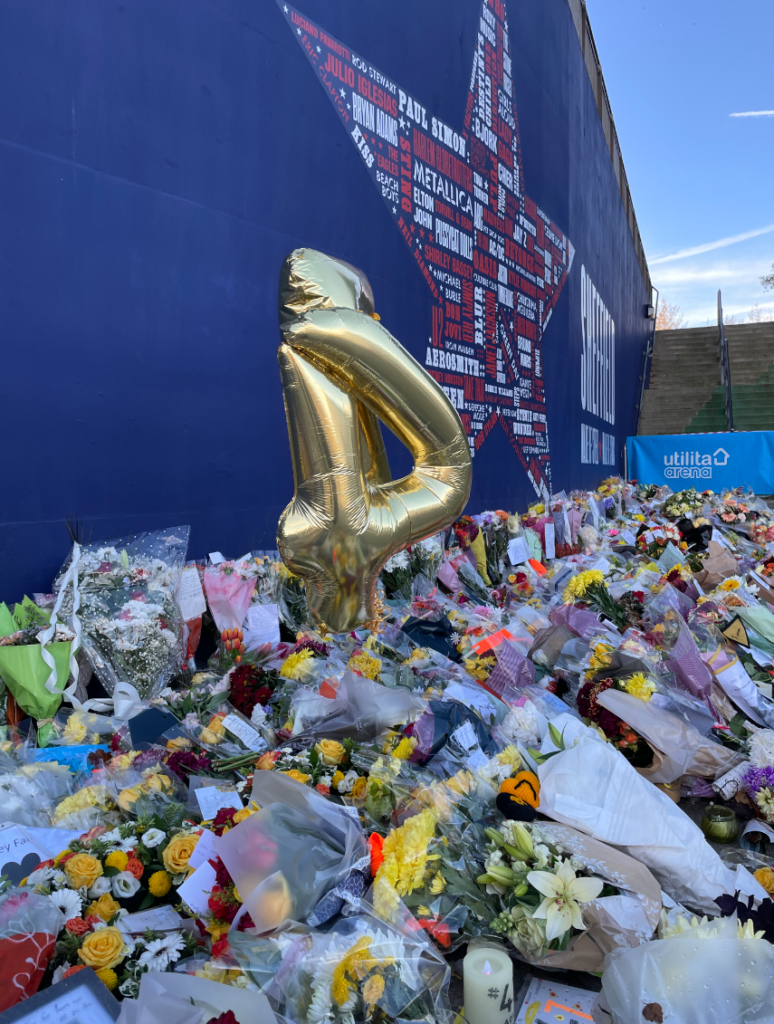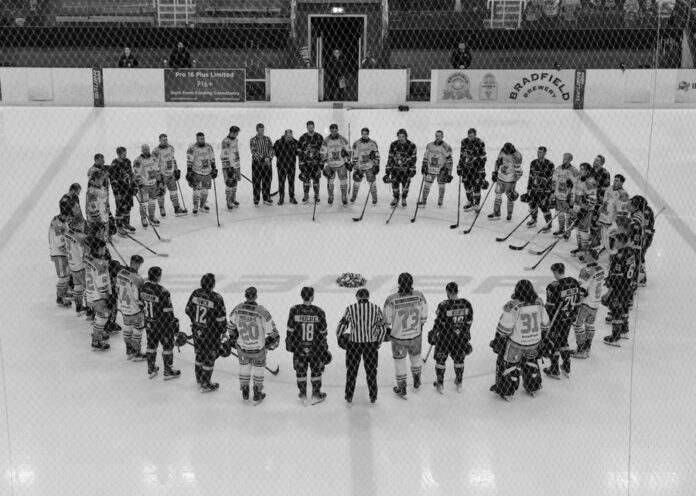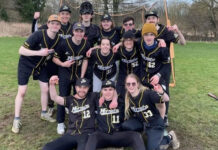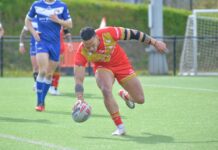As the raindrops fell steadily, I didn’t think much of it. It’s Britain after all, and a little rain is part of the deal. So, with an air of anticipation, I made my way towards the arena. It was my very first time experiencing a live professional ice hockey match, and I couldn’t have been more thrilled.
Inside the arena, the energy was palpable. The crowd roared with cheers, and children dressed up as everything from pumpkins to mummies danced to the music. The commentator’s voice filled the air with enthusiasm as he narrated the game’s twists and turns. The camera zoomed in on parents and babies recreating the popular scene from The Lion King and on kids showing off their best Halloween costumes.
Sheffield’s Utilita Arena was a sea of orange ice hockey jerseys, with fans proudly displaying their favourite players’ names. Laughter filled the stands as people enjoyed their drinks.
Proudly wearing my Sheffield beanie, a symbol of my connection to my university, my second home, I settled into the front row alongside my best friend, Ruth. She was there as a reporter, an opportunity I had convinced her to take on weeks earlier.
We were sports journalists. We had the best seats in the house, which is why we saw it unfold so clearly.
The world of ice hockey was profoundly shaken by the tragic incident that unfolded during the Sheffield Steelers vs. Nottingham Panthers match on 28 October, resulting in the untimely passing of Adam Johnson.
In what Nottingham Panthers described as a ‘freak’ accident, their number 47 suffered a severe neck injury following a collision with the Steeler’s Matt Petgrave.
In the face of this harrowing event, the response of those present was nothing short of heroic. Paramedics swiftly arrived at the scene to provide immediate assistance. Players from both teams came together to swiftly open the gate and assist in bringing a stretcher for transport. It was in this moment that the true spirit of unity and compassion shone through.
In their statement, Sheffield Steelers wrote about such courageous actions: “As a club, we are a family, and it is important that we support each other and those across our sport.
“Nothing could have mentally or emotionally prepared us for what happened during that game, but the players from both teams, the officials and medical professionals who responded should be praised for their swift actions and professionalism in such a difficult moment.”
Journalism student Ruth George, 20, from the University of Sheffield, was there alongside me as a sports reporter when the incident took place.
She said: “There had been fights before, so I didn’t really think anything of it when I saw two players collide on the ice. I remember seeing a lot of blood, and at first, I thought he’d broken his nose, and it was just bleeding really badly. But I’ll never forget how Adam tried to get up, only to fall down again.
“Everyone was shouting for him to get up. But then, you could feel a shift in the arena when everyone realised something was wrong. The doctors and physios from both teams went onto the ice and suddenly, everything stopped.”
Ruth vividly remembers a doctor administering CPR as the severity of the situation became painfully apparent.
She continued: “It felt like forever when they were treating him. But the fact that all the players came together to shield Adam in his most vulnerable moment was really touching, and I’m glad they did that – I hate the thought that he had thousands of people watching him at that moment, and I hate that I was one of them.”
As the public was told to leave, there were tears not only in the eyes of kids but also in adults. It spoke volumes about the tight-knit ice hockey community; their care for the players ran deep, even when they were on opposing sides. It was a moment when team rivalries faded, and everyone shared a common hope for Adam’s well-being, regardless of the jersey they wore.
Saturday night was a difficult one to go through. Lacking sleep and updates, Sunday arrived and alongside it, so did the news. Adam Johnson had passed away.
Receiving the news, Ruth said: “I had no idea what to do, save that I knew I had to do a story about a man I’d watched in his final moments. I felt awful, sitting at my laptop searching for all his personal information as everyone else grieved. People call journalists vultures, and I honestly felt like one, even though I was crying a bit as I wrote the story – it was the first time I had to cover real-life trauma.
“I felt like I’d gone to the match to do a job, so I wanted to finish it, but I felt so bad for his family and friends. No one deserves to die like that, and it feels wrong that I never met him, I didn’t know him as a person, but I still saw what happened to him, and I was writing about it.”
The global sporting community continues to show support to the Nottingham team every day, with minutes of silence having been taken in matches such as the Pittsburgh Penguins and Anaheim Ducks.
Forever a part of the Penguins family.
Just now at PPG Paints Arena: "Ladies and gentlemen, please stand and cheer, one more time, for #47, Adam Johnson." pic.twitter.com/SBrBPlSF33
— Pittsburgh Penguins (@penguins) October 30, 2023
Following the devastating news, the Nottingham Panthers confirmed that all their Elite League games had been postponed until further notice.
Furthermore, Sheffield Steelers cancelled their game on 4 November against Manchester Storm to give their players a chance to deal with the traumatic event. In their statement, they said: “The thoughts, prayers, and condolences of everyone at the Steelers are with Adam’s family and his team, the fans and everyone affected.
“We have heard how much Adam loved this sport, and when the ice hockey community returns to arenas in the coming weeks, we will pay our respects and honour his memory by holding a minute’s applause.
“Then we will do what Adam loved. Our players, coaches and fans will show the passion they have for this sport and, while we will never forget the loss of Adam’s life, over time, a sense of normality and the incredible family spirit will also return to our arenas.”
Adam Johnson’s tragic death has sparked a number of improvements in ice hockey safety measures.
In an online statement, the English Ice Hockey Association (EIHA) said: “As in all sports, the safety of our players must take precedence above all else. We are firmly committed to our obligation to exhaust every possible means to ensure that a tragic incident of this nature never befalls our sport again.”
This long moment of darkness in the sporting community has led EIHA to implement measures to prevent the reoccurrence of similar accidents. As expected, the global reaction to this tragedy has sparked discussions about changes in ice hockey safety measures on an international level.
In fact, USA Hockey continues to “suggest” that players wear neck guards, with the actual enforcement of this recommendation varying across different regions. The National Collegiate Athletic Association (NCAA) also refrained from imposing mandatory neck guard usage.
On the other hand, all players under the age of 16 are obligated to wear neck guards in Canada, regardless of their playing location. However, once players progress to the major junior level, which is a crucial step towards a professional career, the regulations concerning neck guard usage once again fluctuate based on the specific league.
Such changes in ice hockey safety measures have been put aside for years, despite previous similar incidents. In 1989, Clint Malarchuk, the goaltender for the Buffalo Sabres, suffered a severe injury when his throat was slashed by a skate during a game against the St. Louis Blues. This terrifying incident occurred as two players collided near his net. Despite receiving 300 stitches, Malarchuk displayed remarkable resilience by returning to the ice within two weeks.
Nearly two decades later, in 2008, Richard Zednik found himself in a similar situation when his throat was accidentally cut by an errant skate belonging to his own teammate during a game between the Florida Panthers and the Sabres. Fortunately, Zednik recovered, although the injury forced him to miss the remainder of the season.
Throughout this period, only two NHL players opted to wear any form of neck coverings. One of these players was Tomas Plekanec, whose choice of a turtleneck “earned him ridicule” according to the Guardian.
After Johnson’s passing, EIHA announced that neck guards will become mandatory from 2024. However, the Association only oversees English and Welsh hockey below the level where Petgrave and Johnson played, meaning that it is still unknown if the Elite League will follow EIHA’s new mandate.
Their plans include:
- SHORT TERM (immediate): The EIHA makes a “strong recommendation” that all players at all levels across English ice hockey use an approved neck guard whilst participating in all on-ice activities. This guidance is in place until 31 December 2023, after which it will become a mandatory requirement. It is not mandatory with immediate effect due to anticipated supply issues.
- MEDIUM TERM (within 12 months): The EIHA, in consultation with relevant stakeholders, will conduct a player safety equipment review considering all aspects of player safety equipment including, but not limited to, the use of helmets, mouthguards/gumshields and facial protection.
- LONG TERM: The EIHA will provide its membership with clear guidance on the ongoing and continuous improvement of player safety and their duties within this area. This will include the requirement for all clubs to be able to demonstrate that they proactively manage player safety within their organisations.
Reacting to neck guards being made mandatory, Ruth said: “I think for everyone involved it’s just the most tragic thing, but hopefully some good can come out of it, even if it’s just that players want to wear neck guards now. There should be no shame in wearing one, not after Saturday.
“I never want to see something like that again, knowing that so many children were there in their Halloween costumes. I never want to see another jersey with blood on it, even if it’s just for a spooky costume.”

In honour of Adam Johnson, a Nottingham Panthers fundraiser has been launched to raise money for the ‘Love for Hibbing and Hockey Memorial Fund’ – supporting local charitable activities in Hibbing (Adam Johnson’s hometown), as chosen by his family.
Experiencing trauma, whether as a player or part of the audience witnessing tragic incidents, can be emotionally challenging. Seeking help is important for both groups, as it allows individuals to process the distress and grief experienced.
In their statement, the Steelers embraced the idea of seeking support. They said: “The safety and wellbeing of players and coaching staff is our main priority during this incredibly difficult time. All of them have access to professional mental health support to help them come to terms with the tragic events of last weekend. Each will return to the arena in their own time, and we are giving them all our full support.”
In relation to this, Ruth, as an audience member, said: “I live next to a busy road that heads toward the Royal Hallamshire Hospital, so I hear ambulances go past every hour or so, and now I hate hearing sirens. They all make me think of that night, watching as they presumably took Adam away, and it still makes me feel sick and shaky.
“I don’t cry, but whenever people ask me if I’m all right, I don’t know if I am. I’m not sure if I should feel grief, but I sort of do, even if it’s just because I watched until the very last second. So I try not to think about that night, even when someone talks about it.
“There’s nothing I can do, other than keep doing my work as a journalist. I want to go back to ice hockey and keep reporting it since it’s a sport I like. I want to be there when the Steelers and Panthers return to the ice to remember him, and maybe that will be closure for me. Either way, I wish it had never happened.”
The following help and support is available for those who may need it: https://www.england.nhs.uk/london/our-work/mental-health-support/help-and-support/
Image Credit: @steelershockey via X





